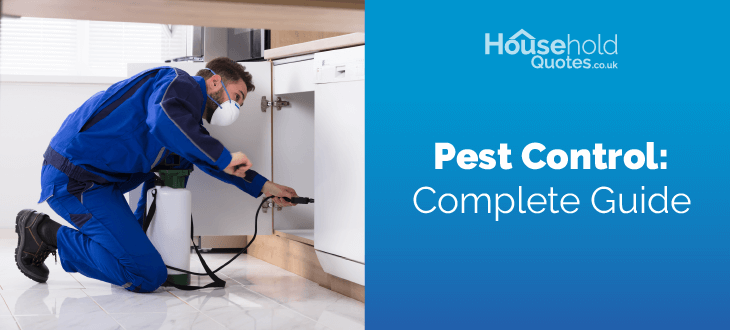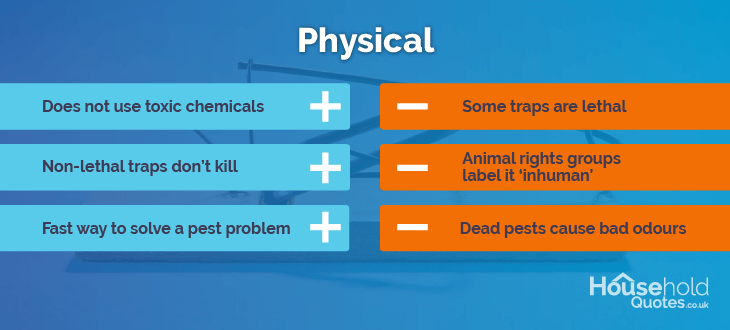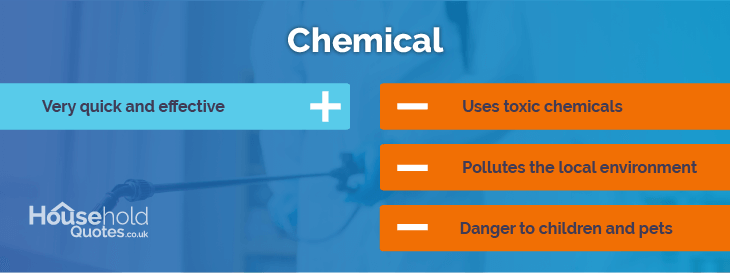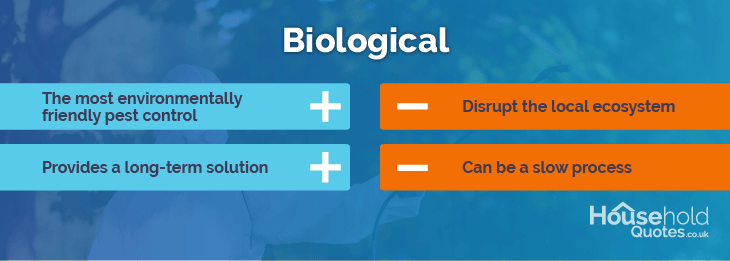- Householdquotes.co.uk
- Blog
- Pest Control Complete Guide: 2024
Why Is Pest Control So Important?


When it comes to our home or workplace, a hygienic environment is crucial for good living and working conditions. One common factor that can cause damage to your belongings and physical health is pests.
Pests can include; birds, insects, rats and mice. All of which aim to invade your space for resources such as food, warmth and shelter. As tempted as you might to keep a little mouse friend, pests can carry harmful bacteria which can cause serious illness if consumed. So it’s not surprising that people affected by these little nuisances turn to pest control to solve their problems. Farmers Weekly claim that climate change may increase pest threats, so pest control might become even more of a key part of our lives.
What is pest control?
Pest control is the process of managing and stopping pests from causing damage to facilities, crops, food and other areas. There are three types of pest control:
Physical pest control
This is where you exterminate, trap or block pests from entering a location. Examples include; wall spikes, lethal traps, non-lethal traps, decoys and ultrasonic repellers.

Chemical pest control
Chemicals are often used to exterminate pests, these include poison which is laid for consummation and pesticides to kill insects on plants.

Biological pest control
Biological pest control is when third parties such as predators and plants are introduced into the environment. Predators will hunt your pests, and certain plants repel them, sorting your problem in a more natural way.

Signs you have pests
Damage
You might notice bite marks on equipment or packaging containing food. Mice and rats like to chew on different materials causing holes.
Droppings
Pests such as mice, rats and pigeons all leave droppings when in an area. If you spot these then this is a sign that you have pests. Insect droppings are more difficult to spot so it’s unlikely that you’ll notice a bug infestation through droppings.
Nests
Nests are a clear sign of pests, birds and wasps nests are relatively easy to locate, whereas rodent nests can be harder to find. They can be difficult to remove as they’re often high off the ground, especially in big warehouses.
Footprints
Spotting small footprints normally means you have a pest problem, but the good news is that you can use those tracks to locate them.
Smell
Due to the amount of dropping pests can leave, it could cause a foul odour. Not all foul odours are pests, as there are plenty of explanations for why a room might smell bad. But keep pests in mind if there is an unexplainable stench, and investigate for dropping.
Body marks
Some pests may leave marks on your body whilst you sleep, the most notorious for this are bed bugs. Bed bug bites are normally bright red and come in clusters on your body.
Problems with pests
Poor hygiene
Pests can carry harmful bacteria that can cause serious illness if consumed. This bacteria can get onto the floor, food and equipment of your property. Some pests such as rats, mice and birds leave very visible droppings, this is unhygienic for obvious reasons.
Property damage
As mentioned earlier, pests can cause a lot of damage to your home and garden. They like to bite into things like cardboard boxes which can often store food. Walls are another area that is seriously affected, it’s been known for rats to eat their way through them. This can leave the property owner with a hefty bill for repairs.
Bad business reputation
If a customer was to see pests on your business's property then this could lead to a bad reputation. Word spreads quickly now through social media, so you could lose out on some very important customs. If your business is in the food industry, you can be inspected at any time with no prior warning. Pests will lead to an automatic low rating which is available for the public to see online.
Seven expert tips for keeping pests away
1. Secure your bins
Bins can be a meet and greet station for potential pests, they’d thrive feeding off leftover pieces of food. Ensure that your bins are secure and can’t be blown over in the event of bad weather. Make sure the bin lid is fully closed, as any open space will be taken advantage of by pests.
2. Seal the cracks
One of the ways pests get access to your property is through the cracks in your walls, or under garage shutters. Inspect your building to ensure that your walls are fully sealed. If you have a garage, buy seals and install them under the door to prevent pests from entering.
3. Don’t leave food out
Make sure to throw away or properly store any leftover food. Pests are attracted to resources, and you leaving them a free meal might as well be a free invite into your home. Clean your surfaces after eating, and give your kitchen floor a good mop. Whilst cooking, avoid having the outside door open, the food may attract pests.
4. Regular cleaning
Give your home a regular thorough clean. Pick up rubbish and scrub surfaces and the inside of your cupboards. An untidy home won’t necessarily attract pests, but an uncluttered home allows you to more easily spot the signs of their presence.
Invest in a good quality hoover if you don’t already have one, these will make sure that those little insects hiding in your carpet are dealt with properly. As if they’re not, nests can be built resulting in deep infestations inside your property.
5. Good ventilation
Poor ventilation in rooms can result in dampness and mould growing on the walls and ceiling. This makes a perfect breeding ground for insects and harmful organisms that can multiply very quickly. Ventilation allows air to flow, reducing the risk of dampness and mould, and therefore a pest infestation.
6. Flea treatment
One of the ways pests can get into your home is through your pets. Cats and dogs are particularly vulnerable to carrying fleas, these can then transfer onto your carpets or bedsheets if you’re not careful. So check your pets regularly for signs of fleas, and provide the appropriate treatment.
7. Call the expert
If you’re particularly worried about pests in or around your home then contact an expert. They will be able to deal with any pest problems you may have, or might simply put your mind at ease letting you know you don’t have a pest problem.

Josh Houston is a writer at Household Quotes whose passionate about the world of renewable energy, energy saving solutions and home improvements. He specialises in providing useful tips that our readers can adopt for their own needs. His skills involve translating complex topics to something more understandable.
